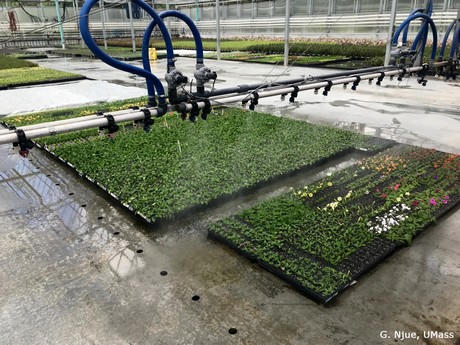Managing moisture during rooting of vegetative cuttings is critical for achieving uniform rooting. Before sticking cuttings it is important to thoroughly moisten the media (rooting soil). Apply water slowly to obtain uniform distribution (wetting). This may require 2-3 applications. A well-moistened substrate will make sticking easier. Avoid applying too much water to the rooting media. Excess moisture may lead to leaching and waterlogged substrate which may cause uneven rooting and loss of cuttings due to rot.
by Geoffrey Njue, UMass Extension Greenhouse Crops & Floriculture Program
Since cuttings do not have roots, they cannot replace water lost through transpiration. Transpiration should be minimized until root formation and development occurs and cuttings gain the ability to replace lost water through root uptake. This can be done by maintaining high humidity around the cuttings. High humidity can be maintained by misting to supply enough moisture on the leaves to prevent wilting and desiccation. Misting can be provided by an overhead misting system or boom misting system.

A greenhouse boom misting system in action
After sticking the cuttings and during the callusing stage (first 3-4 days), cuttings should be misted for 5-8 seconds every 5-10 minutes over each 24 hour period. After 3-4 days, begin to taper by reducing misting to 3-5 seconds every 10-20 minutes during the day and less frequently during the night. Appropriate frequency of misting usually depends on the plant species and weather conditions. Misting should be more frequent when it is sunny and less frequent when it is cloudy.
Light is also important for rooting cuttings. Light levels that are too low cause plants to root slowly, and high intensity light can stress the cuttings and cause them to drop leaves. Do not expose cuttings to direct sunlight. Diffused sunlight normally provides enough light for optimum rooting of cuttings.
After cuttings have rooted, misting can be stopped and cuttings can be irrigated and fertilized with low rate nutrition (50 – 70 ppm N) because they can absorb water and nutrients through the roots.
For more information on moisture management for rooting cuttings, visit: https://www.canr.msu.edu/news/moisture_management_during_vegetative_cutting_propagation
Source: UMassAmherst
